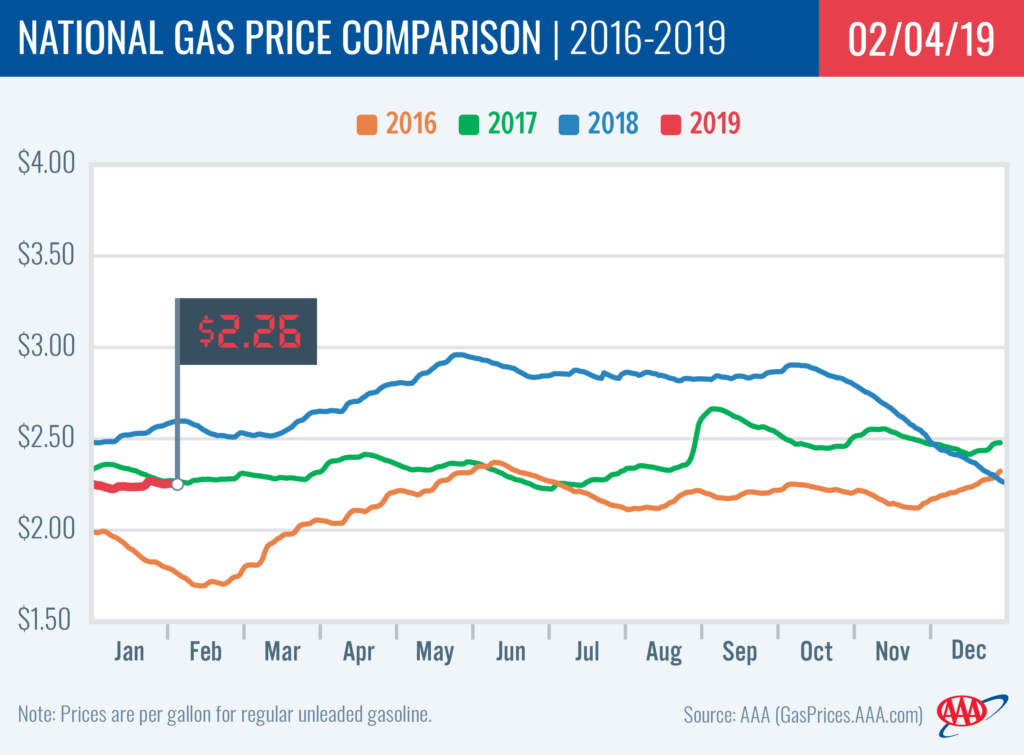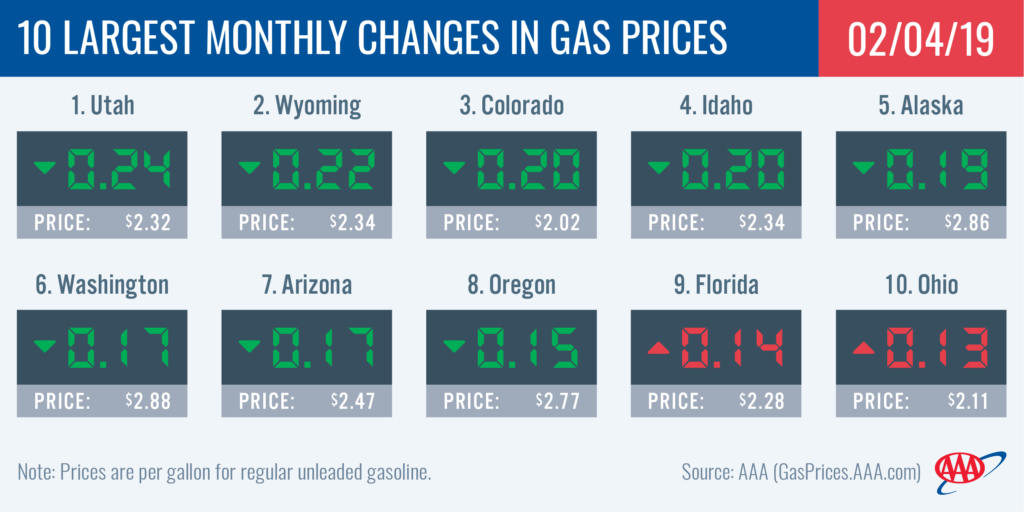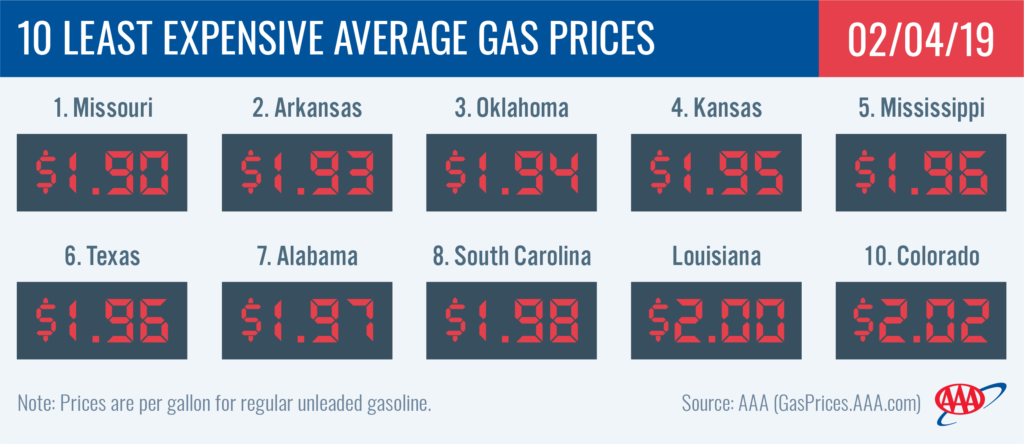For most states, gas prices are starting off the first week in February cheaper than the last week in January. On the week, only eight states saw gas prices increase which is a big shift from the week prior that saw increases for 25 states. With the majority of state gas price averages decreasing, the national gas price average held flat at $2.26 even though the Energy Information Administration’s (EIA) latest demand rate reflected summer-like numbers.
For the week ending Jan 25, the EIA reported U.S. gasoline demand at 9.6 million b/d. The last time the rate was this high was during the 2018 Labor Day weekend. As the EIA rate is an estimate, it’s considered preliminary and the agency may revise it later this year when it releases final figures for the month. If the estimate is not revised, one reason for the jump could be the extreme cold weather seen last week.
“Three-fourths of the country faced below freezing temperatures last week which may have prompted many motorists, especially in the mid-west, to fill-up early and often ahead of the storm, in turn driving demand. This is similar to what we see prior to hurricanes,” said Jeanette Casselano, AAA spokesperson. “Now that the storm has passed, demand is likely to fall more in-line with typical February estimates.”
Today’s national gas price average is a penny more expensive than a month ago and 34 cents less expensive than a year ago.
Quick Stats
- The nation’s top 10 least expensive markets are: Missouri ($1.90), Arkansas ($1.93), Oklahoma ($1.94), Kansas ($1.95), Mississippi ($1.96), Texas ($1.96), Alabama ($1.97), South Carolina ($1.98), Louisiana ($2.00) and Colorado ($2.02).
- The nation’s top 10 largest monthly changes are: Utah (-24 cents), Wyoming (-22 cents), Colorado (-20 cents), Idaho (-20 cents), Alaska (-19 cents), Washington (-17 cents), Arizona (-17 cents), Oregon (-15 cents), Florida (+14 cents) and Ohio (+13 cents).
Great Lakes and Central
Five of the eight states in the country to see gas prices increase on the week hail from the Great Lakes and Central states (areas hard hit by last week’s Polar Vortex). They include: Illinois (+6 cents), Ohio (+6 cents), Indiana (+4 cents), Wisconsin (+4 cents) and Kentucky (+2 cents). States throughout the rest of the region have averages that are as much as a three-cents cheaper than last week. With last week’s major winter storm in the rear-view mirror, much of the region is digging out as roads are made passable. This will likely contribute toward retail prices mostly holding steady or declining in the week ahead for much of the region.
Year-over-year, motorists in the region are seeing big cost savings, among the largest in the country. Seven states in the region make the top 10 list for largest year-over-year changes, all of which are nearly 50-cents cheaper: Iowa (-58 cents), Nebraska (-55 cents), Minnesota (-53 cents), Michigan (-52 cents), Kansas (-510 cents), North Dakota (-49 cents) and Missouri (-48 cents).
EIA data for the week ending January 25 show gasoline stocks had a marginal increase of nearly 300,000 bbl. Total stocks register at 61.5 million bbl. This past weekend a fire was reported at PBF Energy’s Toledo 188,000 b/d refinery in Ohio. Local media reported that the fire started at the plant when a railroad tanker car containing gasoline exploded. No further information was available and it’s unclear the impact to refinery operations at this time.
South and Southeast
The majority of South and Southeast states are seeing gas prices decline by as much as three-cents. Florida (+6 cents), Oklahoma (+1 cent) and Louisiana (+1 cent) are the exception for the week. Two likely contributing factors to the fluctuation is this week’s substantial, nearly 4 million bbl draw in gasoline stocks combined with refinery maintenance season. With the draw, total stock levels fall to 86.6 million bbl, but continue to measure at a year-over-year surplus.
Most states in the region continue to carry averages at or below the $2/mark. Arkansas ($1.93), Oklahoma ($1.94), Mississippi ($1.96), Texas ($1.96), Alabama ($1.97), South Carolina ($1.98) and Louisiana ($2.00) carry the cheapest gas prices averages in the region and are among the 10 least expensive in the country.
Rockies
2019 continues to usher in cheaper gas prices for motorists in the Rockies region. Since January 1, retail prices are, on average, 23-cents cheaper: Utah (-26 cents), Wyoming (-24 cents), Idaho (-23 cents), Colorado (-23 cents) and Montana (-16 cents). With the decreases, Colorado’s average drops to $2.02 and ranks as the 10th least expensive average in the entire country. Prior to January, gas prices haven’t been this cheap in Colorado since March 2016.
With the exception of Montana, all Rockies states landed on this week’s top 10 list with the biggest changes. Pump prices declined the most in Utah (-5 cents). Gas prices range between $2.02 and $2.35.
The EIA reports that with the addition of 90,000 bbl, gasoline stocks in the region built slightly for the week ending January 25 and total 7.3 million bbl.
Mid-Atlantic and Northeast
Washington, D.C. ($2.53), New York ($2.49) and Connecticut ($2.48) are the most expensive state gas price averages in the region and among the highest in the country. On the week, gas prices are one to three cents cheaper for every state in the region. Connecticut ($2.48), Delaware ($2.14) and Tennessee ($2.03) all saw the largest decreases on the week.
As the region’s refineries enter into turnaround season, the EIA reports utilization dropped from 88.6 to 72.4 percent for the week ending January 25. Despite the lower operating rate, stocks increased nearly 1 million bbl to register at 69 million bbl. The healthy supply will help to keep gas prices stable for motorists in the region. Over the weekend a crude unit fire at PBF Energy’s 190,000 b/d Delaware City, Del. refinery required several fire companies to bring it under control. It’s unclear the overall damage and impact the fire has had to the refinery at this time.
West Coast
Motorists in the West Coast region are paying some of the highest pump prices in the nation, with all of the region’s states landing on the nation’s top 10 most expensive list. At $3.25, California and Hawaii are the most expensive markets. Washington ($2.89), Nevada ($2.85), Alaska ($2.86), Oregon ($2.77) and Arizona ($2.47) follow. While still expensive, prices have mostly fallen on the week. Arizona (-4 cents) and Washington (-3 cents) saw the largest drops.
EIA’s recent weekly report showed that West Coast gasoline stocks grew by approximately 400,000 bbl to 32.8 million bbl. However, stocks are approximately 1.1 million bbl lower than at this time last year, which could cause prices to spike if there is a supply challenge in the region this week.
Oil market dynamics
At the close of Friday’s formal trading session on the NYMEX, WTI increased $1.47 to settle at $55.26. Oil prices mostly increased last week, following indications of tightened global supply this year. Alongside OPEC’s production reduction agreement of 1.2 million b/d for the first six months of 2019, the recently announced U.S.-imposed crude export ban on Venezuela has made market observers worry that global crude supplies will shrink and rebalance prices. Worries over tighter supplies amid robust demand, which could dampen because of the continued trade tensions between China and the U.S., will likely continue to lift the global price of crude.
Moreover, EIA’s weekly petroleum report this week showed that total domestic crude inventories grew by 1 million bbl last week to 446 million bbl, much less than the market expected and despite crude production maintaining its record-breaking pace at 11.9 million b/d last week. Moving into this week, crude prices will likely continue their ascent, making headway for increased gasoline prices after winter.
In related news, Baker Hughes Inc. reported that the U.S. lost 15 oil rigs last week, bringing the total to 847. When compared to last year at this time, there are 82 more rigs this year.
Motorists can find current gas prices along their route with the free AAA Mobile app for iPhone, iPad and Android. The app can also be used to map a route, find discounts, book a hotel and access AAA roadside assistance. Learn more at AAA.com/mobile.



